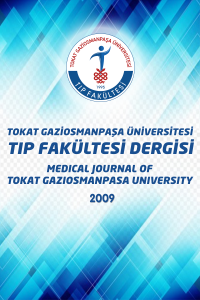Geriatrik Hastaların Bir Yıllık Retrospektif Değerlendirilmesi
Amaç:Hastanemize başvuran ve herhangi bir nedenle operasyon geçiren yaşlı hasta grubunun (65 yaş üstü), uygulanan anestezi yöntemini, cerrahi şeklini ve yoğun bakım ihtiyacının incelenmesi amaçlanmıştır. Gereç ve Yöntemler:Ağustos 2011 ve Temmuz 2012 tarihleri arasında ameliyat olmuş toplam 631 hasta retrospektif olarak değerlendirildi. Hastalar; yaş, cinsiyet, acil, elektif, kullanılan anestezi yöntemi, operasyon yapılan anabilim dalı ve postoperatif yoğun bakım ihtiyacı açısından değerlendirildi. Bulgular:Hastaların %19’unun acil, %81’inin elektif olarak cerrahi operasyona alındığı saptandı. En sık uygulanan anestezi yöntemi %78.3 ile genel anestezi olurken, en sık uygulanan rejyonel anestezi yöntemi ise %13.2 ile spinal anestezi olarak saptandı. Genel anestezi uygulanan 63 hasta, spinal anestezi uygulanan 3 hastanın postoperatif yoğun bakım ünitesine alındığı görüldü. Sonuç:Bu grup hastalara yaklaşım konusunda protokoller oluşturularak, gerekli eğitimler sonrası deneyimli ekiplerin kurulması gerektiği kanaatindeyiz.
The Retrospective Evaluation of Geriatric Patients in One Year
Aim:We aimed to evaluate, the anesthesia method, surgery type and intensive care requirement of the elderly patients (over 65 years-old) who were accepted into our hospital and applied surgical operation. Material and Methods:Six hundred and thirty-one patients who underwent surgical operation between August 2011 and July 2012, were assessed retrospectively. Patients were evaluated in terms of age, gender, requirement of urgent or elective surgical operation, used anesthesia method, name of surgical clinic and requirement of intensive care. Results:19% patients were operated under urgent conditions and 81% patients were performed elective surgery. Since the most performed anesthesia method was general anesthesia in 78.3%, the most used regional anesthesia technique was spinal anesthesia in 13.2 %. 63 patients after general anesthesia and 3 patients after spinal anesthesia were taken into intensive care in postoperative period. Conclusion: Protocols should be made for these group of patients after necessary training, thereafter establishment of experienced teams are required.
